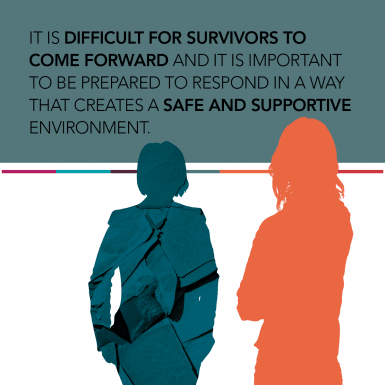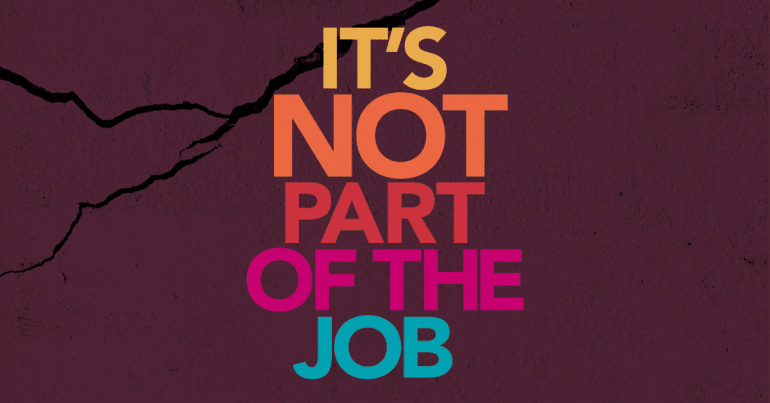 Responding to Disclosures
Responding to Disclosures
Develop your skills to support others
It is difficult for survivors to come forward and it is important to be prepared to respond in a way that creates a safe and supportive environment.
Here are some ways you can support a member who has chosen to disclose experiencing sexual violence in the workplace: [i]
- Follow the lead of the member and ask what their desired outcome is.
- Treat them with dignity and respect.
- Assist them in obtaining care for physical or mental injuries.
- Engage in emotional support and active listening:
- Be mindful of your body language
- Affirm what is being shared
- Make sure to not interrupt and rush the survivor as they are disclosing
- Ask what support is needed
- Listen with care
- Provide resources
- Be sure to limit questions you may have about their experience of violence – ask yourself “am I asking this out of curiosity?” or is knowing the answer critical for next steps?
- Allow the survivor to have control over their disclosure (e.g. if they want to disclose; what to disclose; how much to disclose; and to whom).
- Be sensitive of needs and experiences that may be based on race, gender, culture, religion, sexuality and disability.
- Be aware of your biases and assumptions and potential barriers to disclosure.
- Offer to help the survivor identify workplace resources and options on what to do next.
Taking notes can be helpful. Remember that notes taken throughout the process of supporting and investigating the incident can be subpoenaed by the courts if a legal proceeding follows from the incident.
Options for investigations and resolution
Be sure the member remains at the centre of the process. This means respecting their control over disclosure and the process that may follow. The union should engage with the member who has experienced harm. Listen for their needs and be transparent, honest and consistent about the roles and responsibilities of the employer and the union. Communication must be regular and ongoing to help build trust and confidence in the process, and trust and confidence of all members in the workplace.
Every situation is different, and it is critical that the survivor understands that they have choices. A resolution may take the form of an apology. It might involve mediation or an informal resolution. However, any resolution should involve the participation of everyone involved, especially the survivor.
It is important to recognize uneven power positions when engaging in informal processes. These processes can put pressure on the survivor, and sometimes cause intimidation. A worker may agree to resolutions that are not in their best interest or do not meet their needs, because the perpetrator is in a position of authority over them or has informal power at work. Check in with the survivor about their responses and choices during informal processes to make sure their needs and safety are met.
Some CUPE locals attempt to mediate incidents of conflict between union members, without employer involvement. Misunderstandings can be cleared up before they escalate, and no one will be disciplined by the employer. However, conflict resolution should not be undertaken in cases of violence. There is serious potential to make the situation worse and to create harm. People who have experienced violence and harassment should never be forced to confront the perpetrator unless they choose to do so, and only with appropriate supports and safety planning. They can also file a grievance or other complaints. Mediation is not recommended unless performed by a qualified person.
Before the local tries to resolve a dispute in the workplace between union members, without involving the employer, they should consider the following:
1. Do not try to set up a mediation of any type unless you are certain that both sides are interested in voluntarily participating and that this is a safe option for both participants.
2. A person who is qualified and experienced in mediation should be brought in to mediate the dispute and must speak independently with both members before the mediation process begins. The members must both agree to the choice of the mediator.
3. The most common practice for dispute mediation is that neither side has an outside advocate or outside representation during the mediation sessions. However, it is advisable that stewards and/or CUPE national representatives be used to represent and/or support each side. These and other details must be worked out before the mediation can begin.
4. Both parties must agree to the following:
- All discussions in the mediation process will remain confidential, without prejudice or precedent for either party.
- All communication will be done in a respectful manner.
- All parties will actively participate in the discussion and listen to what others are saying.
- Each participant considers what they are doing or not doing that might be contributing to the conflict.
- Each participant will assist in finding solutions to the conflict.
5. Some members opt for a group circle, or other forms of alternative dispute resolution. Sometimes a respected and trusted neutral person, either from within the local, a CUPE staff person or someone external, can act as facilitator for these sessions.
6. If the members can reach a resolution, they must ensure that all facts of the situation are agreed upon so that there are no residual misunderstandings.
7. Workers must be made aware that, if they agree to participate and are unable to reach a resolution and the situation continues, either party may still decide to use formal workplace avenues such as a grievance or complaint. Then the employer would get involved and the issue would no longer be dealt with solely by the local.
8. Until all sides have agreed that the dispute has been settled, always leave the opportunity to proceed formally with the employer as an option.
There are situations where mediation should not take place:
1. Do not force a survivor of sexual violence or harassment to confront the perpetrator or harasser. Confrontation or mediation may put the survivor at greater risk of harm.
2. If there has been any crime committed (for example, an assault), then the union must attempt to obtain the survivor’s consent to notify the employer. In any case, the union should never attempt to hide evidence or cover-up for a member accused of a crime.
3. If the parties have not agreed to all the terms of the mediation, such as the items listed above, the mediation should not go forward.
It should be suggested that the survivor access their health and safety committee and use the grievance procedure to address workplace sexual violence. Even if there is no collective agreement language on workplace sexual violence, it can still be grieved.
The union has a legal duty to represent all members. If another member is the alleged perpetrator, the union should ensure that the employer conducts a fair and thorough investigation and disciplinary process. Remember, the union has the legal duty to represent all members in good faith, without discrimination and in a manner that is not arbitrary.
Different union representatives, for example the stewards, must be assigned to the person making the complaint and the respondent. The two union representatives should not communicate details of the complaint to any other member of the union. Information should only be shared on a “need to know” basis. This should be clearly outlined in the violence policy and collective agreement language and made clear to all parties involved.
The local may help a survivor:
- Secure sick leave or other leaves
- File a workers’ compensation claim
- Get a temporary work reassignment
- Access resources such as counselling, medical and legal support through workplace benefits, employee assistance programs, community agencies and services.
Police may become involved in some circumstances. Members may be reluctant to access the criminal justice system for many reasons. Provide members with support and information to help them decide whether they would like the police to become involved. If a worker believes that they or anyone is at immediate risk of violence, they should call the police. If others are at risk, including children and other workers, it may also be necessary for others (for example, a supervisor) to contact the police.
Many incidents are criminal, for example stalking, sexual assault or death threats. If these occur in the workplace, the employer has an obligation to report to the authorities such as the government departments for occupational health and safety, workers compensation boards or the police. If the employer does not do so, the union may make a report or assist the member to do so.
When taking notes, be aware that the police or arbitrator may compel the union to produce them if a legal proceeding follows the incident. If the police are involved and demand that the union turn over records, they must provide a subpoena. In this instance, the local should immediately seek legal advice. Contact your national servicing representative to help the local access legal advice.
Disclosing vs. Reporting
Disclosing does not require a person to file a formal complaint. It is making it known to someone that an incident of sexual violence. In certain circumstances, a person who receives a disclosure may be obliged to act to protect others from harm, as necessary.
Reporting is making a formal statement or complaint about someone or something to the necessary authority.
[i] Centre for Research and Education on Violence Against Women and Children, Overcoming Barriers and Enhancing Supportive Responses: The Research on Sexual Violence against Women, Western University, May 2012.






